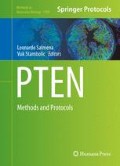Abstract
Recent advancements have driven the development of smaller footprint, less expensive, and user-friendly flow cytometers introducing the technology to more users.
Flow cytometry is an established tool for multiparametric analysis of various important cellular characteristics. Fluorescent dyes or fluorophore-conjugated antibodies allow for measurement of protein expression, identification of cell populations, or DNA content analysis. This is combined with analysis of light-scattering detection to determine cell size and complexity to allow for the study of complex cell samples, such as whole blood. Through antibody staining for a variety of surface markers as well as intracellular proteins we can also elucidate intracellular signaling, and phosphor-signaling, on a single-cell basis.
Here we describe the application of flow cytometry analysis to the tumor suppressor PTEN in various cancer cell lines and a mouse model.
Access this chapter
Tax calculation will be finalised at checkout
Purchases are for personal use only
References
Brown M, Wittwer C (2000) Flow cytometry: principles and clinical applications in hematology. Clin Chem 46:1221–1229
Shapiro H (2003) Practical flow cytometry, 4th edn. Wiley-Liss, New York
Picot J, Guerin CL, Le Van Kim C, Boulanger CM (2012) Flow cytometry: retrospective, fundamentals and recent instrumentation. Cytotechnology 64:109–130. doi:10.1007/s10616-011-9415-0
Krutzik PO, Irish JM, Nolan GP, Perez OD (2004) Analysis of protein phosphorylation and cellular signaling events by flow cytometry: techniques and clinical applications. Clin Immunol 110:206–221. doi:10.1016/j.clim.2003.11.009
Krutzik PO, Clutter MR, Nolan GP (2005) Coordinate analysis of murine immune cell surface markers and intracellular phosphoproteins by flow cytometry. J Immunol 175:2357–2365. doi:10.4049/jimmunol.175.4.2357
Collins S, Gallo R, Gallagher R (1977) Continuous growth and differentiation of human myeloid leukaemic cells in suspension culture. Nature 270:347–349. doi:10.1038/270347a0
Breitman TR, Collins SJ, Keene BR (1980) Replacement of serum by insulin and transferrin supports growth and differentiation of the human promyelocytic cell line, HL-60. Exp Cell Res 126:494–498. doi:10.1016/0014-4827(80)90296-7
Sundström C, Nilsson K (1976) Establishment and characterization of a human histiocytic lymphoma cell line (U-937). Int J Cancer 17:565–577
Phillips TA, Ni J, Pan G et al (1999) TRAIL (Apo-2L) and TRAIL receptors in human placentas: implications for immune privilege. J Immunol 162:6053–6059
Wang C, Curtis J, Minden M, McCulloch E (1989) Expression of a retinoic acid receptor gene in myeloid leukemia cells. Leukemia 3:264–269
Hollink IHIM, Feng Q, Danen-van Oorschot AA et al (2012) Low frequency of DNMT3A mutations in pediatric AML, and the identification of the OCI-AML3 cell line as an in vitro model. Leukemia 26:371–373. doi:10.1038/leu.2011.210
Lange B, Valtieri M, Santoli D et al (1987) Growth factor requirements of childhood acute leukemia: establishment of GM-CSF-dependent cell lines. Blood 70:192–199
Quentmeier H, Reinhardt J, Zaborski M, Drexler HG (2003) FLT3 mutations in acute myeloid leukemia cell lines. Leukemia 17:120–124. doi:10.1038/sj.leu.2402740
Shen FW, Saga Y, Litman G et al (1985) Cloning of Ly-5 cDNA. Proc Natl Acad Sci U S A 82:7360–7363. doi:10.1073/pnas.82.21.7360
Haycocks NG, Lawrence L, Cain JW, Zhao XF (2011) Optimizing antibody panels for efficient and cost-effective flow cytometric diagnosis of acute leukemia. Cytometry B Clin Cytom 80B:221–229. doi:10.1002/cyto.b.20586
Bossuyt X, Marti GE, Fleisher TA (1997) Comparative analysis of whole blood lysis methods for flow cytometry. Cytometry 30:124–133
Fox C, Johnson F, Whiting J, Roller P (1985) Formaldehyde fixation. J Histochem Cytochem 33:845–853. doi:10.1056/NEJMra1313875
Pollice AA, McCoy JP, Shackney SE et al (1992) Sequential paraformaldehyde and methanol fixation for simultaneous flow cytometric analysis of DNA, cell surface proteins, and intracellular proteins. Cytometry 13:432–444. doi:10.1002/cyto.990130414
Le Maire M, Champeil P, Møller JV (2000) Interaction of membrane proteins and lipids with solubilizing detergents. Biochim Biophys Acta 1508:86–111. doi:10.1016/S0304-4157(00)00010-1
Dahia PLM, Aguiar RCT, Alberta J et al (1999) PTEN is inversely correlated with the cell survival factor Akt/PKB and is inactivated via multiple mechanisms in haematological malignancies. Hum Mol Genet 8:185–193. doi:10.1093/hmg/8.2.185
Acknowledgements
The research in the Salmena lab is supported by funds from Canada Research Chairs, Human Frontier Science Program Organization, Leukemia and Lymphoma Society of Canada, Canadian Cancer Society, and the Natural Sciences and Engineering Research Council of Canada.
Author information
Authors and Affiliations
Corresponding author
Editor information
Editors and Affiliations
Rights and permissions
Copyright information
© 2016 Springer Science+Business Media New York
About this protocol
Cite this protocol
Woolley, J.F., Salmena, L. (2016). Measurement of PTEN by Flow Cytometry. In: Salmena, L., Stambolic, V. (eds) PTEN. Methods in Molecular Biology, vol 1388. Humana Press, New York, NY. https://doi.org/10.1007/978-1-4939-3299-3_4
Download citation
DOI: https://doi.org/10.1007/978-1-4939-3299-3_4
Published:
Publisher Name: Humana Press, New York, NY
Print ISBN: 978-1-4939-3297-9
Online ISBN: 978-1-4939-3299-3
eBook Packages: Springer Protocols

